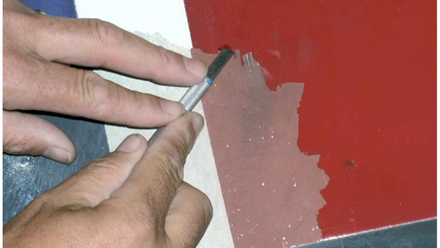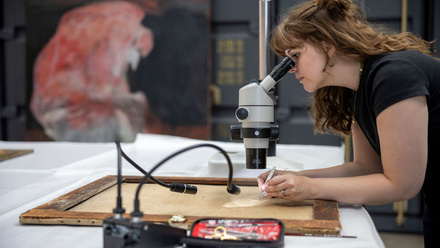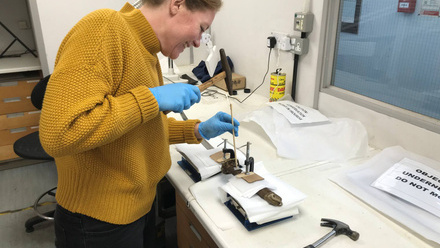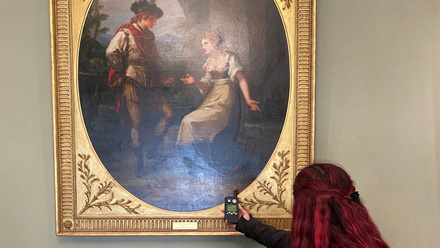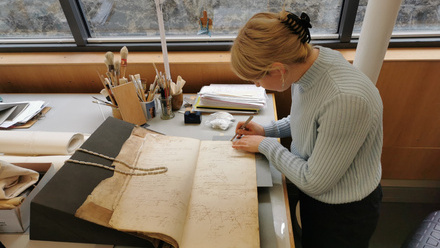During my year as the HLF & Icon paintings conservation intern at the Bowes Museum I was fortunate enough to work on a variety of paintings, both from the museum’s collection and privately owned. One such picture belonging to a private client found its way into the studio and has immediately captured my interest because of its “dual personality”.
The painting in question arrived at the studio lying on a board since it wasn’t stretched on to a secondary support of any kind. It was of a Reclining Nude, most likely dating between the 1930s and 1950s, painted in an impasto style.

Reclining Nude - before treatment
The surprise, however, came during documentation of the painting. When turning it over to examine the back of the picture, a second painting was revealed!
The Portrait of a Man dressed in a light suit was staring back at me where I expected to find bare canvas. Upon closer examination, I realised this portrait was the “right side” of the painting, since the linen fabric support on that side was commercially prepared with a ground layer. This is a preparatory coat to ensure better adhesion of the paint to the surface. The same cannot be said for the side of the Reclining Nude which was painted directly on to the bare canvas. This showed that the artist first painted the Portrait of a Man, then changed his mind and used the other side.

Portrait of a Man
There are a number of reasons why an artist would re-use the same canvas, either by painting on top of a painting or, in this case, on the back of one.
Artists’ materials such as fabric supports were expensive, so sometimes an artist would re-use them for financial reasons. Also, if they were not pleased with their original painting, or they could not sell it they might re-use the canvas to produce another work. Finally, if they considered the work a study instead of a finished painting, they would use the canvas again to make the most of it.
This particular painting did not have a signature, any labels or inscriptions, so the identity of the artist remains unknown, much like his reasons behind the “double painting”.
Conservation issues with the painting included blanching in places obscuring the true colours of the paint layer on both sides, paint losses and flaking paint on the Reclining Nude. The painting was also unvarnished and had a water-sensitive surface.

Details of paint loss and blanching on the top left side of the Reclining Nude
To treat the paintings, the Reclining Nude was consolidated with Isinglass (sturgeon glue), applied locally with a small brush. Once the flaking paint was secured, surface cleaning tests showed the preferable agent to remove the blanching was de-ionised water, with a safety margin of five swab rolls to account for the sensitivity of the paint layer.
The painting was then placed face down on a silicone release paper over jiffy foam so that the impasto would be protected, resting against a softer surface. Then, the Portrait of a Man in the other side of the painting was cleaned mechanically with a smoke sponge, (like using a giant soft rubber) removing the blanching from the surface.

Portrait of a Man during cleaning
The tacking margins were flattened using a combination of damp blotting paper and weights. In order to reinforce the tacking margins and increase their width to allow the canvas to be tensioned on a stretcher the painting was strip-lined, i.e. a new piece of canvas was attached all around the paintings edge. An inert synthetic fabric was used, the edges frayed to avoid a ‘hard edge’ and attached with a heat activated adhesive film.
As this was a water-sensitive surface, the areas surrounding the paint losses were protected with a low miscibility solvent prior to filling in order to prevent filler spreading outside the fill area. The losses were then filled with a conservation grade acrylic putty using a small palette knife and textured with dental tools to imitate the surrounding impasto. The fills were subsequently retouched with acrylic paints, as they gave a surface finish well matched to the original. It is easily removed if required in the future.

After strip-lining and filling of losses on painted surface
Even though a protective coating of varnish is often the final step in a conservation treatment, this painting was not varnished as the artist had decided not to varnish, giving it a semi matte surface finish and this decision was respected.
The Reclining Nude was kept as the primary painting and it was re-attached onto a stretcher to enable to be hung on a wall. This decision was reached taking into account the artist’s choice to re-use the canvas to produce the Reclining Nude and it was finished, unlike the portrait. Both of which facts indicate that intended that to be the final painting. When the painting is framed, a transparent backing can be placed on the back to both protect the painting and keep the Portrait of a Man visible from the back.

Attaching the painting on a stretcher using staples
Working on this painting (or should I say paintings!) was fascinating as it gave me an insight into the artist’s mind, discovering their thought process and following their decisions. The aim of any conservation treatment is to interfere as little as possible with the original work and respect the artist’s intent. The painting is now stabilised, visually re-integrated and ready to be enjoyed for many years to come.


Reclining Nude - after treatment
---
Written by Lito Angelaki, HLF & Icon Intern in the Conservation Department at the Bowes Museum.
To find our more about the Icon Internship Programme and to see the current vacancies please click here.

